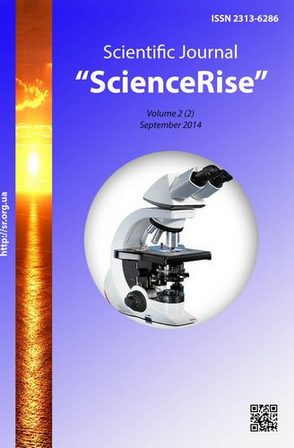Chaotic processes in thin-wire emitter with the nonlinear properties of the surface impedance
DOI:
https://doi.org/10.15587/2313-8416.2014.27266Keywords:
nonlinearity, convergence, dynamic chaosAbstract
The work examines simulation results for non-convergent devices. Investigation results for a thin-wire radiator with non-linear surface impedance are represented. It is demonstrated that explicit attributes of the dynamic chaos regime are observed in the strong nonlinearity mode
References
Danilov, L. V. (1970). Nelinejnye konvergentnye jelektricheskie cepi. Teoreticheskaja jelektrotehnika, 9,87–93.
2. Sinickij, L. A. (1960). O periodicheskom rezhime v jelektricheskoj cepi, soderzhashhej nelinejnye soprotivlenija. Avtomaticheskij kontrol' i izmeritel'naja tehnika. Kiev, AN USSR, 4, 54–57.
3. Luchaninov, A. I., Zhurbenko, V. V. (2005). Jelektrodinamicheskie ustrojstva s nelinejnymi svojstvami poverhnostnogo impedansa. Uslovie konvergentnosti. Radiotehnika, 140, 19–27.
4. Luchaninov, A. I., Gavva, D. S., Krikyn, E. V. (2011). Convergence condition for non-linear electrodynamic devices. Radioelectron.Commun.Syst., 54 (2), 104–113. doi:10.3103/s0735272711020063
5. Fpanchesketti, Dzh., Pinto, I.; Uslengi, P. (Ed.) (1983). Antenny s nelinejnoj nagpuzkoj. Nelinejnye jelektpomagnitnye volny. Moscow: Mir, 221–249.
6. Shifrin, Ja. S., Luchaninov, A. I.; Bahrah, L. D., Zelkin, E. G. (Ed.) (1997). Antenny s nelinejnymi jelementami. Spravochnik po antennoj tehnike. Vol. 1. Moscow: Izd-vo IPRZhR, 207–235.
7. Shifrin, Ja. S., Luchaninov, A. I., Posohov, A. S. (2001). Strukturnaja model' antenny s nelinejnymi jelementami. Radiotehnika, 122, 22–34.
8. Sheshyekani, K., Sadeghi, S. H. H., Moini, R. (2008). A Combined MoM-AOM Approach for Frequency Domain Analysis of Nonlinearly Loaded Antennas in the Presence of a Lossy Ground. IEEE Trans. Antennas Propagat., 56 (6), 1717–1724. doi:10.1109/tap.2008.923352
9. Zinchenko, M. V., Zin'kovs'kyj, Ju. F. (2010). Modeljuvannja ansamblju symetrychnyh vibratoriv z nelinijnmy navantazhennjamy rjadjamy Vol'terra-Pikara. Visnyk KPI. Serija Radiotehnika. Radioaparatobuduvannja, 41, 148–156.
10. Shyfryn, Ja. S., Luchanynov, A. Y., (2000). Omarov, M. A. Analyz antenn s raspredelennoj nelynejnost'ju. Antenni, 1 (44), 70–83.
11. Collado, C., Mateu, J., O’Callaghan, J. M. (2001). Nonlinear simulation and characterization of devices with HTS transmission lines using harmonic balance algorithms. IEEE Trans. Appl. Supercond., 11 (1), 1396–1399. doi:10.1109/77.919612
12. Luchaninov, A. I., Gavva, D. S., Krikun, E. V., Vishnjakova, Ju. V., Nazarenko, V. A. (2011). Investigation of the properties of nonlinear non-convergent electrodynamic devices. Eastern-Europen Journal of Enterprise Technologies, 6/5(54), 68–72.
13. Loskutov, A. Ju., Mihajlov, A. S. (1990). Vvedenie v sinergetiku. Moscow: Nauka, 272.
14. Landt, J. A. (1981). Network loading of thin-wire antennas and scatterers in the time domain. Radio Science, 16 (6), 1241–1247. doi:10.1029/rs016i006p01241
15. Porti, J. A., Morente, J. A. (1994). A numerical analysis of wire antennas loaded with varistor-composite materials. IEEE Trans. Electromagn. Compat., 36(1), 23–31. doi:10.1109/15.265476
16. Gavva, D. S., Luchaninov, A. I., Omarov, M. A., Shokalo, V. M.; Kashheeva, B. L., Proshkina, E. G., Lagutina, M. F. (Ed). (2002). Raschet parametrov provolochnyh izluchajushhih struktur proizvol'noj konfiguracii. Distancionnye metody i sredstva issledovanija processov v atmosfere Zemli. Khar'kov, 399–425.
17. AWR Design Environment 2010. User Guide (2010). AWR Corporation, 378.
Downloads
Published
Issue
Section
License
Copyright (c) 2014 Анатолий Иванович Лучанинов, Дмитрий Гавва Сергеевич, Сальман Рашид Уайд

This work is licensed under a Creative Commons Attribution 4.0 International License.
Our journal abides by the Creative Commons CC BY copyright rights and permissions for open access journals.
Authors, who are published in this journal, agree to the following conditions:
1. The authors reserve the right to authorship of the work and pass the first publication right of this work to the journal under the terms of a Creative Commons CC BY, which allows others to freely distribute the published research with the obligatory reference to the authors of the original work and the first publication of the work in this journal.
2. The authors have the right to conclude separate supplement agreements that relate to non-exclusive work distribution in the form in which it has been published by the journal (for example, to upload the work to the online storage of the journal or publish it as part of a monograph), provided that the reference to the first publication of the work in this journal is included.

